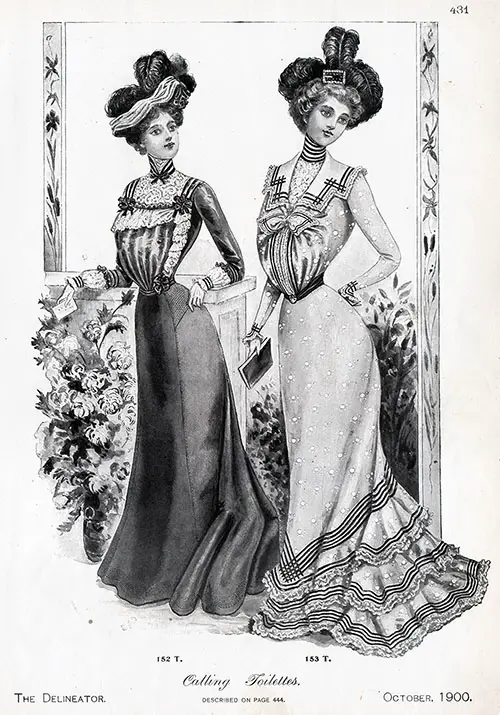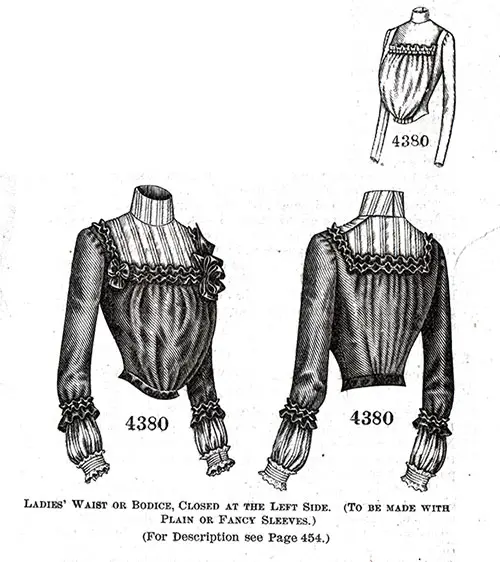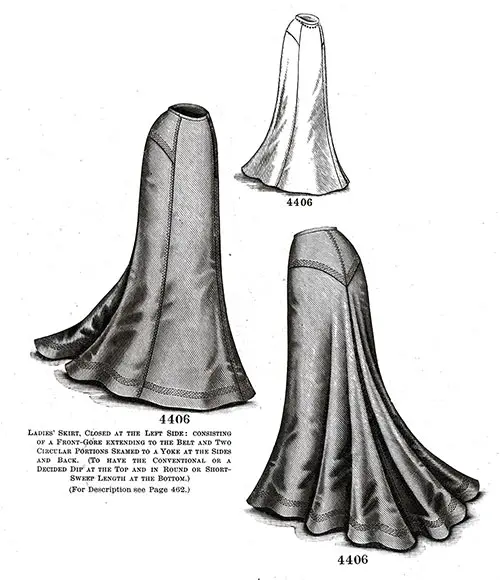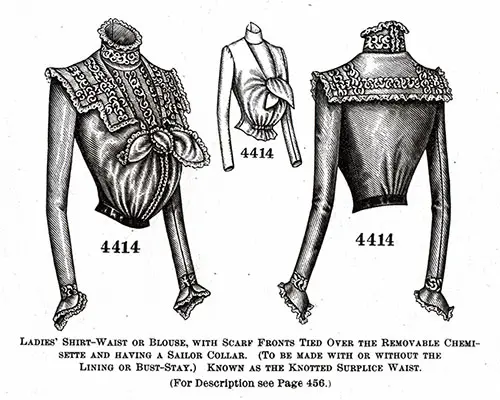Ladies Calling Costumes 152 T and 153 T - 1900

Described on Page 444 | For Illustrations see Page 431.
Ladies’ Calling Costume No. 152 T
Unites a Ladies’ blouse and skirt.
Description
Yoke-blouses have attained great popularity this season, and the charming one forming part of this fashionable costume is sure to win admiration. It is pictured here made of lavender silk in combination with figured net and is decorated with lace frills and ribbon.
The skirt is of fine broadcloth of a darker shade and is finished in tailor style with machine-stitching. The fronts and back of the blouse are in Pompadour outline and reveal the smooth yoke, which is finished with a standing collar.
The blouse has pretty fulness at the center of the front and back regulated by shirrings, those at the top forming a frill heading. The fronts puff out stylishly, and the closing is made at the left side. The sleeve is an important feature of the mode and is quite fancy.
It consists of an over-sleeve that is gathered to form a frill heading just below the elbow and a short full under-sleeve completed with a wristband.
The skirt is a unique design, introducing a yoke at the sides and back, and is described fully at Figure No. 143 T.
Dressmaker Options
The blouse may be developed with favorable effect in taffeta, surah, Liberty and India silks or soft woolens combined with all-over lace or fancy tucking, and the skirt in vicuna, camels-hair, serge, twill, cross-canvas meshes and English suiting.
Pattern Information
The blouse pattern, which is No. 4380 and costs 10d. or 20 cents, is in seven sizes for ladies from thirty to forty-two inches, bust measure, and is again shown on page 446.
The skirt pattern, which is No. 4406 and costs Is. or 25 cents, is in nine sizes from twenty to thirty-six inches, blouse measure, and is differently pictured on page 456.
Ladies' Blouse or Bodice No. 4380

No. 4380 Ladies' Blouse or Bodice, Closed at the Left Side. (To be made with Plain or Fancy Sleeves.)
For Description see Page 454 | For Illustrations see Page 446
No. 4380.—Another illustration of this blouse is given at figure No. 152 T in this magazine.
Description
Dainty in every detail is the blouse here represented developed in olive-green vailing associated with fancy white tucking and trimmed with lace edging and ribbon niching and bows.
The blouse is made with the fashionable dip in front and is shaped to accommodate a square yoke, closed at the left side, and has gathered fulness at the center of the front and back, the fulness at the top being arranged to form a frill finish.
The fronts puff stylishly, the right front overlapping the narrow left-front and the closing being made invisible. At the sides, the blouse is smooth, and a plain standing collar gives completion to the neck.
The pattern provides for either a plain two-seam sleeve or a fancy sleeve in “1850” style, consisting of a slightly full one-seam upper part ending in a frill a short distance below the elbow and a short, full under-portion that is completed with a wristband.
The fancy sleeve is mounted on a close-fitting, two-seam lining, which may be cut away beneath the undersleeve. A belt of ribbon is worn, and the blouse is made over a dart- fitted lining closed at the center.
Dressmaker Options
A pretty blouse could be developed in beige Lansdowne associated with white silk mousseline and turquoise - blue panne. Satin surah, foulard, China silk, cashmere, voile, satin Liberty, etc., are appropriate materials for the development with any decoration desired.
Pattern Information
We have pattern No. 4380 in seven sizes for ladies from thirty to forty-two inches, bust measure.
To make the blouse or bodice for a lady of medium size requires a yard and five-eighths of material forty-four inches wide with a yard and an eighth of material twenty inches wide for the 'yoke, collar, wristbands and under-sleeves.
Price of pattern, 10d. or 20 cents.
Ladies' Skirt, Closed at the Left Side No. 4406

No. 4406 Ladies' Skirt, Closed at the Left Side: consisting of a Front-Gore extending to the Belt and Two Circular portions Seamed to a Yoke at the Sides and Back. (To have the Conventional or a Decided Dip at the Top and in Round or Short- Sweep Length at the Bottom.)
For Description see Page 462 | For Illustrations see Page 456
At figures Nos. 143 T, 152 T and 163 T in this number of The Delineator this skirt is shown differently made up.
Description
The sheath-like adjustment over the hips and the dip at the top of the front are points of interest in the skirt here shown made of gray cloth, finished with rows of machine stitching and closed above-the left side- front seam.
The skirt forms a front-gore that extends to the belt with two circular sections joined to a smooth yoke and have their fullness at the back laid in an under-folded box-plait.
The yoke shapes a point at the lower edge of the back and each lower front corner, and the dip may be slight or very decided, as preferred.
The mode may be in round or short-sweep length and ripples attractively toward the foot, wherein the medium sizes the skirt measures about three yards and one-half.
Dressmaker Options
Broadcloth. Venetian or covert cloth, serge, Cheviot, and all tailor fabrics, as well as vailing, cashmere, etamine, drap d’été, etc., are suitable for the development of the mode.
Pattern Information
We have pattern No. 4406 in nine sizes for ladies from twenty to thirty-six inches waist, or thirty-seven to fifty-eight and a half inches hip measure.
To make the skirt for a lady of twenty-four inches waist or forty-one inches hip requires three yards and one-half of goods fifty inches wide.
Price of pattern, Is. or 25 cents.
Ladies’ Calling Costume No. 153 T

This embraces a Ladies’ shirt-waist and skirt.
Description
Lace, which has been so lavishly employed as a garniture in this season’s costumes, has a close rival in black velvet ribbon, many effective results being achieved by the employment of the latter.
Black velvet ribbon was associated with silk ruchings in the decoration of the stylish costume here pictured made of figured and plain India silk and all-over lace.
The shirt-waist or knotted surplice is distinguished by scarf fronts tied over a removable chemisette and has gathered fulness at the bottom both front and back. The waist blouses fashionably in front, and the fancy sailor- collar is a stylish feature of the mode.
The comfortably close sleeves are of the two-seam variety and have flare cuffs that fall over the hand, and a high standing collar finishes the neck of the chemisette.
Three graduated circular flounces contribute to the gracefulness of the five-gored skirt, which is fitted perfectly smooth at the top by a dart at each side and has pretty fullness at the back disposed in an underlying box-plait.
Dressmaker Options
Vailing, voile, Lansdowne, cashmere, Liberty satin, taffeta and many other fabrics will pleasingly develop both the skirt and blouse. The collar could be of batiste, grass linen, fine lawn, embroidery or lace and the chemisette of tucked material.
Pattern Information
The shirt-waist pattern, which is No. 4414 and costs 10d. or 20 cents, is in seven sizes for ladies from thirty to forty-two inches, bust measure, and is again shown on page 449.
The skirt pattern, which is No. 3892 and costs Is. or 25 cents, is in seven sizes from twenty to thirty-two inches, waist measure.
Ladies’ Shirt-Waist or Blouse No. 4414

For Illustrations see Page 449 | For Description see Page 456
No. 4414 Ladies’ Shirt-Waist or Blouse with Scare Fronts Tied Over the Removable Chemisette and Having a Sailor Collar. (To Be Made with or without the Lining or Bust-Stay.) Known as the Knotted Surplice Blouse.
Another pretty development of this blouse is shown at figure No. 153 T in this number of The Delineator.
Description
Any variation of that indispensable garment, the shirt-waist, will be sure to meet with hearty approval, and the novel design shown, in surplice style, will become a universal favorite.
The garment is often called the knotted surplice blouse, and for its present development white China silk was chosen with lace insertion and edging for decoration.
The scarf fronts are gathered at the waistline and are drawn up and knotted softly at the bust. At the top, they are shaped to display a removable chemisette that is made with a cape back and is gathered at the waistline.
The chemisette droops with the fronts fashionably and is topped by a standing collar. The back extends only to the waistline, where it is gathered slightly at the center and is lengthened by a circular skirt-section.
A sailor collar that is deep and square at the back and has fanciful front ends adds to the attractiveness of the mode. The close-fitting sleeves are completed with flared cuffs, and a ribbon belt is worn.
A bust-stay, and a lining fitted with single bust darts, under-arm gores, and a center seam, are included in the pattern, but the use of either is optional.
Dressmaker Options
The design is especially appropriate for the development of soft fabrics, such as vailing, cashmere, albatross, Lansdowne, soft silks, etc. For wear in warm climates, dimity, lawn and such materials may be used with lace for trimming.
Pattern Information
We have pattern No. 4414 in seven sizes for ladies from thirty to forty-two inches, bust measure. To make the shirt-waist for a lady of medium size requires four yards and three-eighths of fabric twenty inches wide. Price of pattern, 10d. or 20 cents.
"Descriptions of Figures in Colors, Tints, Etc., Shown on First Page of Cover and Pages 423 to 437 Inclusive," in The Delineator: An Illustrated Magazine of Literature and Fashion, Paris-London-New York: The Butterick Publishing Co. Ltd., Vol. LVI, No. 4, October 1900, p. 431, 444, 446, 449, 454, 456, 462.
Editor's Note: Some terminology used in the description of women's clothing during the 1800s and early 1900s has been changed to reflect more modern terms. For example, a women's "Toilette" -- a form of costume or outfit has an entirely different common meaning in the 21st century. Typical terms applied to "toilette" include outfit, ensemble, or costume, depending on context.
Note: We have edited this text to correct grammatical errors and improve word choice to clarify the article for today’s readers. Changes made are typically minor, and we often left passive text “as is.” Those who need to quote the article directly should verify any changes by reviewing the original material.
